3M Hearing Protection DL DPR Operating instructions
- Type
- Operating instructions
3M Hearing Protection DL DPR is a digital level-dependent earplug designed to protect your hearing in noisy environments while allowing you to hear important sounds.
- Noise reduction rating (NRR): 26 dB
- Automatically adjusts volume based on surrounding noise levels
- Four listening modes: Normal, Attenuate, High Noise, Communication Boost
- Rechargeable battery lasts up to 16 hours
- Bluetooth connectivity for phone calls and streaming audio
- Sleek, low-profile design for all-day comfort
Use cases:
- Construction sites
- Manufacturing facilities
- Concerts and sporting events
- Commuting in noisy environments
3M Hearing Protection DL DPR is a digital level-dependent earplug designed to protect your hearing in noisy environments while allowing you to hear important sounds.
- Noise reduction rating (NRR): 26 dB
- Automatically adjusts volume based on surrounding noise levels
- Four listening modes: Normal, Attenuate, High Noise, Communication Boost
- Rechargeable battery lasts up to 16 hours
- Bluetooth connectivity for phone calls and streaming audio
- Sleek, low-profile design for all-day comfort
Use cases:
- Construction sites
- Manufacturing facilities
- Concerts and sporting events
- Commuting in noisy environments

Fifth in a comprehensive series of technical monographs covering topics related to hearing and hearing protection.
Hearing Protector Performance:
How They Work - and - What Goes Wrong
in the Real World
BY ELLIOTT H. BERGER
Senior Scientist, Auditory Research
In previous EARLogs
1
we have dis-
cussed how to measure and rate the
attenuation of hearing protection de-
vices (HPDs) in the laboratory, how
these devices affect auditory commu-
nications, and perhaps most impor-
tantly how HPDs perform in real world
(RW) environments. It was found that
laboratory attenuation measurements
significantly overestimate the RW per-
formance of HPDs, due to the unreal-
istic, optimized manner in which experi-
mental subjects can wear these devices
for short duration tests. In this, EARLog
#5, we will examine these concepts fur-
ther by analyzing how a correctly worn
HPD operates and how its effectiveness
is compromised by misuse, misfitting,
HPD aging, and abuse.
Sound Transmission to the
Unoccluded Ear
The hearing mechanism can be divided
into three parts as shown in Figure 1.
These are the outer, middle and inner
ear. Sound (airborne vibration) is re-
ceived by the outer ear. The incident
sound propagates along the auditory ca-
nal, setting the eardrum (tympanic mem-
brane) into motion. The eardrum motion
is transmitted via the tiny middle ear
bones (ossicular chain) to the inner ear,
a liquid filled cavity of complex shape
lying within the bony structure of the
skull. This causes the liquid in a portion
of the inner ear, the cochlea, to vibrate.
Membranes and hair cells inside the co-
chlea, which are very sensitive to this
vibration, generate electrical impulses
when appropriately stimulated. The im-
pulses are transmitted along the audi-
tory nerve to the brain, where they are
“decoded “. The result is the sensation,
sound.
When the vibration that excites the co-
chlear hair cells is the result of the chain
of events described above, this is called
air conduction. When sound directly vi-
brates the skull and/or excites vibration
of the ear canal walls which in turn
stimulates the cochlea, it is called bone
conduction. The final sense organ, the
cochlea, is the same in either case, only
the path of excitation has changed.
Since most sound and/or vibration
sources will excite both transmission
paths, the ear will usually receive both
air conducted and bone conducted sig-
nals simultaneously.
For the normal hearing individual, the
unoccluded ear’s bone conduction (BC)
sensitivity is much poorer than its cor-
responding air conduction (AC) sensi-
tivity as shown in Figure 2, curve A. For
example at 1000 Hz the sensitivity of the
ear is 60 dB poorer for the BC path than
for the AC path. This means that even if
the AC path were totally eliminated by a
HPD, that the ear’s sensitivity would only
be approximately 60 dB worse, i.e. a
“perfect” HPD could only offer 60 dB of
attenuation at 1 kHz. Even if the entire
head was acoustically shielded, the
loudness level of the sound would only
FIGURE 1. Basic Anatomy of the Ear with Illustration of the Air Conduction and
Bone Conduction Sound Paths.

be reduced by an additional 10 dB to =
70 dB below the unoccluded AC thresh-
old.
2
In this latter case, the conduction
path would be from the chest cavity thru
the neck to the head.
Sound Transmission to the Oc-
cluded Ear
The utilization of a HPD modifies the AC
and BC paths discussed in the previous
section. Four distinct sound pathways
can now be distinguished as shown in
Figure 3. There are:
1. Air Leaks - For maximum protection
the device must make a virtual air
tight seal with the canal or the side
of the head. Inserts must accurately
fit the contours of the ear canal and
earmuff cushions must accurately fit
the areas surrounding the external
ear (pinna). Air leaks can typically re-
duce attenuation by 5-15 dB over a
broad frequency range.
3
2. Vibration of the HPD - Due to the
flexibility of the ear canal flesh, ear-
plugs can vibrate in a piston-like
manner within the ear canal. This lim-
its their low frequency attenuation.
Likewise an earmuff cannot be at-
tached to the head in a totally rigid
manner. Its cup will vibrate against
the head as a mass/spring system,
with an effective stiffness governed
by the flexibility of the muff cushion
and the flesh surrounding the ear, as
well as the air volume entrapped un-
der the cup. For earmuffs, pre-
molded inserts and foam inserts
these limits of attenuation at 125 Hz
are approximately 25 dB, 30 dB and
40 dB, respectively.
3. Transmission thru the Material of the
HPD - For most inserts this is gen-
erally not significant, although with
lower attenuation devices such as
cotton or glassdown, this path is a
factor to be considered. Because of
the much larger surface areas in-
volved with earmuffs, sound trans-
mission thru the cup material and
thru the earmuff cushion is signifi-
cant, and can limit the achievable at-
tenuation at certain frequencies.
4. Bone Conduction - Since a HPD is
designed to effectively reduce the
AC path and not the BC path, BC
may become a significant factor for
the protected ear.
When the ear is occluded with an in-
sert or a muff the BC path is enhanced
relative to the unoccluded ear for fre-
quencies below 2 kHz. This is called
the earplug effect
4, 5
or more gener-
ally the occlusion effect.
6,7
This can be
easily demonstrated by plugging one’s
ear canals while speaking aloud. When
the canals are properly sealed or cov-
ered, one’s own voice takes on a bassy,
resonant quality due to the amplifica-
tion of the BC path by which a talker
partially hears his own speech. This
amplification of BC vibrations results
in the differences between curves A
and B in Figure 2. Curve A represents
the threshold of hearing for BC vibra-
tions with open ear canals, whereas
curve B is the threshold of hearing for
BC vibrations with the ear canals
tightly covered or plugged.
Thus, curve B gives the estimated
maximum protection achievable by
covering and/or plugging the ears.
A common myth concerning HPDs is
that as the sound level increases BC
sound becomes more important, and
therefore an earmuff will provide bet-
ter protection than an earplug at higher
sound levels. The inaccuracy of this
statement is demonstrated by the fact
that the relationship between the AC
and BC thresholds, as shown in Fig-
ure 2, is not dependent on sound level.
Any BC advantage that muffs may
have over inserts will be independent
of sound level, and will be apparent in
a standard threshold level attenuation
test such as ANSI S3.19-1974.
Due to the occlusion effects and BC
limitations described above, as well as
other physical considerations, using
muffs and inserts in combination does
not yield attenuation values that are
merely the arithmetic sum of their in-
dividual values. In some cases, at
some frequencies, almost no improve-
ment will be noted when inserting a
pre-molded insert under a muff.
8
Alter-
natively for other combinations, not
fully defined at this time, better results
may be achieved. Curve C in Figure 2
demonstrates performance for a
deeply inserted E-A-R Plug used in
conjunction with a David Clark 19A
earmuff.
9
This combination probably
represents the highest practical attenu-
ation achievable with currently avail-
able HPDs.
Why HPDs Fail in the Real World
When a HPD is properly sized and
carefully fitted and adjusted for opti-
mum performance on a laboratory sub-
ject, air leaks will be minimized and
paths 2, 3 and 4 will be the primary
sound transmission paths. In the RW
work environment, this is usually not
the case, and path 1, sound transmis-
sion thru air leaks, often dominates. Air
leaks arise when plugs do not seal
properly in the ear canal or muffs do
not seal uniformly against the head
around the pinna. The causes of poor
HPD sealing are:
FREQUENCY in Hz (Cycles per Second)
ATTENUATION (dB)
BONE CONDUCTION TO AIR CONDUCTION
RATIO IN dB AND THE ATTENUATION FOR
AN EARPLUG/EARMUFF COMBINATION.
A
B
C
Figure 2
Ratio of Bone Conduction to Air Conduction Thresholds
for Occluded Ear Canals (after Zwislocki
4
).
Ratio of Bone Conduction to Air Conduction Thresholds
for Open Ear Canals (after Zwislocki
4
).
Real-Ear Attenuation (ANSI S3.19-1974) for Deeply Inserted
E-A-R Plug in Combination with David Clark 19A Earmuff.
5 Subjects.
9
A ––
B ––
C ––
50
125
250
500
1000
2000
3000
4000
6000
8000
40
30
70
60
20
10
0
SOUND FIELD AIR
CONDUCTION THRESHOLD
~

FIGURE 3. Illustrations of the 4 Paths by Which Sound Reaches the Occluded Ear.
1. Comfort - In most situations the
better the fit of a HPD, the poorer
the comfort. Inserts must be
snugly fitted into the canal and
earmuff cups must be tightly
pressed against the head. This is
not conducive to comfort and al-
though some employees may
adapt, many will not. This is why
it is important to select several
hearing protectors (generally 1
muff and 2 earplugs) from the
more comfortable available HPDs
and to encourage the employee
to make the final decision as to
which he will use.
2. Utilization - Due to poor comfort,
poor motivation or poor training,
or user problems, earplugs may
be improperly inserted and ear-
muffs may be improperly ad-
justed.
3. Fit - All HPDs must be properly
fitted when they are initially dis-
pensed. For multi-sized pre-
molded inserts a suitably sized
earplug must also be selected
during this fitting procedure.
Companies must stock all avail-
able sizes of multi-sized earplugs
and must be willing to use differ-
ent size plugs for an employee’s
two ears, this latter situation oc-
curring in perhaps 2-10% of the
population. For example, stocking
only 3 of the 5 available sizes of
the V51-R will reduce the percent-
age of the population fitable with
that device from = 95% to = 85%.
The correct size pre-molded in-
sert will always be a compromise
between a device that is too large
and therefore uncomfortable, and
a device that is too small and
therefore provides poor protec-
tion. The appropriate compromise
can often times be achieved, but
only with care and skill.
4. Compatibility - Not all HPDs are
equally suited for all ear canal
and head shapes. Certain head
contours cannot be fitted by any
available muffs and some ear
canals have shapes that may
only be fitable with certain in-
serts or canal caps or some-
times not at all. Earmuffs can
only work well when their cush-
ions properly seal on the head.
Eyeglasses, sideburns, or long
or bushy hair underneath cush-
ions will prevent this and will re-
duce attenuation by varying
amounts.
5. Readjustment - HPDs can work
loose or be jarred out of position
during the day. It must be remem-
bered that laboratory tests re-
quire the subject to carefully ad-
just a device prior to testing. Un-
der typical use, wearers will eat,
talk, move about and may be
bumped or jostled, resulting in
jaw motion and possible perspi-
ration. These activities can cause
muff cushions to break their seal
with the head and cause certain
inserts to work loose.
10,11
Pre-
molded inserts tend to exhibit this
problem, whereas custom
molded and expandable foam
plugs tend to more effectively
maintain their position in the ear
canal.
6. Deterioration - Even when prop-
erly used, hearing protectors
wear out. Some pre-molded plugs
shrink and/or harden when con-
tinuously exposed to ear canal
wax and perspiration. This may
occur in as little as three weeks.
Flanges can break off and plugs
may crack.
12,13
Custom earmolds
may crack, or the ear canal may
gradually change shape with
time, so that the molds no longer
fit properly. Earmuff cushions also
harden and crack or can become
permanently deformed and
headbands may lose their ten-
;
Earplug
;;

E•A•RLog is a registered trademark of Aearo Company. Copyright 1996. First printing 1980.
LIT. CODE 30296 9/98 AG
sion. Therefore it is important to
inspect or reissue ‘’permanent’’
HPDs on a regular basis. This may
be 2-12 times per year or more,
depending upon the HPDs that
are utilized.
7. Abuse - Employees often modify
HPDs to improve comfort at the
expense of protection.
12,13,14
These
techniques include springing ear-
muff headbands to reduce the ten-
sion, cutting flanges off of pre-
molded inserts, drilling holes thru
plugs or muffs, removing the ca-
nal portion of custom earmolds, or
deliberately obtaining undersized
HPDs.
Protection vs. Percentage Time Worn
The HPD RW utilization problems out-
lined in the preceding section explain
why the RW attenuation of HPDs is so
much lower than typical manufacturers’
laboratory data would indicate (as was
extensively discussed in EARLog # 4
1
).
In addition to this problem we must con-
tend with the possibility that employees,
regardless of how well they wear an
HPD, may not wear it during their en-
tire work-shift or period of noise expo-
sure. This will reduce their effective daily
protection.
Noise induced hearing loss has been
shown to be a function of the cumula-
tive A-weighted noise exposure incident
upon the ears.
15,16
Adherents of this
theory propose that the hearing levels
of a noise exposed population can be
estimated from a knowledge of their
equivalent continuous noise exposure
level (L
eq
). The L
eq
is the level of con-
tinuous A-weighted noise that would
cause the same sound energy to be ex-
perienced in an 8-hour day, as resulted
from the actual noise exposure. This
leads to the 3 dB trading relationship,
that is, if the exposure level is increased
by 3 dB, the exposure duration must be
reduced by 1/2. A similar approach is
embodied in the U.S. Occupational
Safety and Health Act
17
, except that the
trading relationship is 5 dB. The impli-
cations of the cumulative energy theory
with regards to the protection afforded
by HPDs, were first discussed by Else.
18
They are presented graphically in Fig-
ure 4, with suitable modifications to con-
form with the OSHA 5 dB trading rela-
tionship.
The data in Figure 4 can be utilized to
determine the Time Corrected Noise
Reduction Rating (NRR) as a function
of the percentage of time that the HPD
is worn in the noise. We first assign an
NRR value to the HPD in question - ei-
ther the manufacturers’ labeled NRR or
preferably a RW estimated NRR. If, for
example, the HPD had an assigned
NRR = 25, then its Time Corrected NRR
would be only 20 dB if it was not worn
for just 15 minutes during each 8 hour
noise exposure. This clearly demon-
strates that HPDs must be comfortable
enough to be worn properly for ex-
tended periods. Attenuation and com-
fort must both be considered when se-
lecting an HPD.
Neither low attenuation nor low comfort
devices are acceptable for standard in-
dustrial use. Comfortable, user accept-
able HPDs, with real world NRRs suit-
able for the prevailing environmental
sound levels will be necessary to pro-
tect your employees’ hearing.
References and Footnotes
Berger, E.H. - The EARLog series is available upon
request from Aearo Company.
Von Gierke, H.E., and Brown, D.R. (1953).
Protection of the Ear From Noise: Limiting Factors
in Benox Report, The Univ. of Chicago. ONR
Project NR 144079, Chicago, IL.
Nixon, C.W. (1979). Hearing Protective Devices:
Ear Protectors in Handbook of Noise Control (2nd
Edition),McGraw-Hill, New York, NY.
Zwislocki, J. (1957). In Search of the Bone-
Conduction Threshold in a Free Sound Field, J.
Acoust. Soc. Am., Vol. 29, No. 7, p. 795-804.
Gasaway, D.C. (1971). Personal Ear Protection.
USAF School of Aerospace Medicine, Report No.
SAM-TR-71-13, Brooks AFB, TX.
Anderson, C.M.B., and Whittle, L.S. (1971 ).
Physiological Noise and the Missing 6 dB.
Acustica, Vol. 24, p. 261-272.
Tonndorf, J. (1972). Bone Conduction in
Foundations of Modern Auditory Theory, Vol. II
,
Academic Press, New York NY.
Gorman, A. G. (1980). New Design Concepts in
Personal Hearing Protectors presented at the
International Symposium on Personal Hearing
Protection in Industry, Toronto, Canada.
Data from E-A-RCAL
SM
Laboratory experiments in
progress.
Maas, R.B. (1972). Industrial Noise and Hearing
Conservation in
Handbook of Clinical Audiology
(1st Edition), Williams and Wilkins Co., Baltimore,
MD.
Ohlin, D. (1975). Personal Hearing Protective
Devices: Fitting, Care and Use. U.S. Army
Environmental Hygiene Agency, Report No. AD-
AO21 408, Aberdeen Proving Ground, MD.
Riko, K., and Alberti, P.W. (1980). How Ear
Protectors Fail: A Practical Guide presented at the
International Symposium of Personal Hearing
Protection in Industry, Toronto, Ontario.
Royster, L.H., and Holder, S.R. (1980). Personal
Hearing Protectors: Problems Associated with the
Hearing Protection Phase of the Hearing
Conservation Program presented at the
International Symposium on Personal Hearing
Protection in Industry, Toronto, Ontario.
Mellard, J.M., Doyle, T.J., and Miller, M.H. (1978).
Employee Education - The Key to Effective Hearing
Conservation. Sound and Vibration, Vol. 12, No. 1,
p. 24-29.
Robinson, D.W. (1971). Estimating the Risk of
Hearing Loss Due to Exposure to Continuous
Noise in Occupational Hearing Loss, Academic
Press, New York, NY.
Atherly, G.R.C., and Martin, A.M. (1971).
Equivalent-Continuous Noise Level as a Measure
of Injury from Impact and Impulse Noise. Ann.
Occup. Hyg., Vol. 14, p. 11-28.
OSHA (1971). Occupational Safety and Health Act,
Federal Register, Vol. 36, No. 105, 29CFR1910.95.
Else, D. (1973). A Note on the Protection Afforded
by Hearing Protectors - Implications of the Energy
Principle. Ann. Occup. Hyg., Vol. 16, p. 81-83.
PERCENTAGE TIME WORN
TIME CORRECTED NRR (dB)
TIME-CORRECTED NRR
AS A FUNCTION OF WEARING TIME
(USING OSHA 5 dB TRADING RELATIONSHIP).
30
5
50
10
15
20
25
25
20
15
10
5
Figure 4
75 88 94 98 99 99.5 99.9
∞
240 2.5 0.510 530120 60
TIME NOT WORN (MINUTES) DURING 8 HOUR EXPOSURE
EXAMPLE (SEE TEXT)
ASSIGNED NRR
1.
2.
3.
4.
5.
6.
7.
8.
9.
10.
11.
12.
13.
14.
15.
16.
17.
18.
-
 1
1
-
 2
2
-
 3
3
-
 4
4
3M Hearing Protection DL DPR Operating instructions
- Type
- Operating instructions
3M Hearing Protection DL DPR is a digital level-dependent earplug designed to protect your hearing in noisy environments while allowing you to hear important sounds.
- Noise reduction rating (NRR): 26 dB
- Automatically adjusts volume based on surrounding noise levels
- Four listening modes: Normal, Attenuate, High Noise, Communication Boost
- Rechargeable battery lasts up to 16 hours
- Bluetooth connectivity for phone calls and streaming audio
- Sleek, low-profile design for all-day comfort
Use cases:
- Construction sites
- Manufacturing facilities
- Concerts and sporting events
- Commuting in noisy environments
Ask a question and I''ll find the answer in the document
Finding information in a document is now easier with AI
Related papers
-
3M Hearing Protection DL DPR Operating instructions
-
3M Hearing Protection DL DPR Operating instructions
-
3M Hearing Protection DL DPR Operating instructions
-
3M Hearing Protection DL DPR Operating instructions
-
3M Hearing Protection DL DPR Operating instructions
-
3M Hearing Protection DL DPR Operating instructions
-
3M Hearing Protection DL DPR Operating instructions
-
3M Hearing Protection DL DPR Operating instructions
-
3M Hearing Protection DL DPR Operating instructions
-
3M Hearing Protection DL DPR Operating instructions
Other documents
-
Stalwart M550096 User manual
-
Etymotic Research ER20XS-SMF-P Operating instructions
-
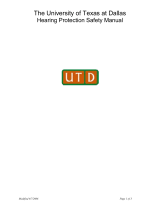 Mutt Muffs DDR337 User manual
Mutt Muffs DDR337 User manual
-
Harbor Freight Tools Reusable Corded Earplugs User manual
-
Harbor Freight Tools 46798 User manual
-
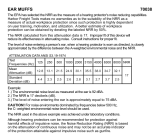 Western Safety 70038 Owner's manual
Western Safety 70038 Owner's manual
-
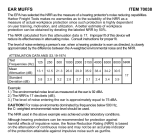 Western Safety 70038 Owner's manual
Western Safety 70038 Owner's manual
-
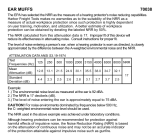 Western Safety Item 70038-UPC 792363700382 Owner's manual
Western Safety Item 70038-UPC 792363700382 Owner's manual
-
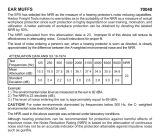 Western Safety Item 70040 Owner's manual
Western Safety Item 70040 Owner's manual
-
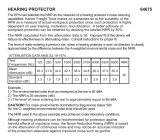 Western Safety 64675 Owner's manual
Western Safety 64675 Owner's manual









